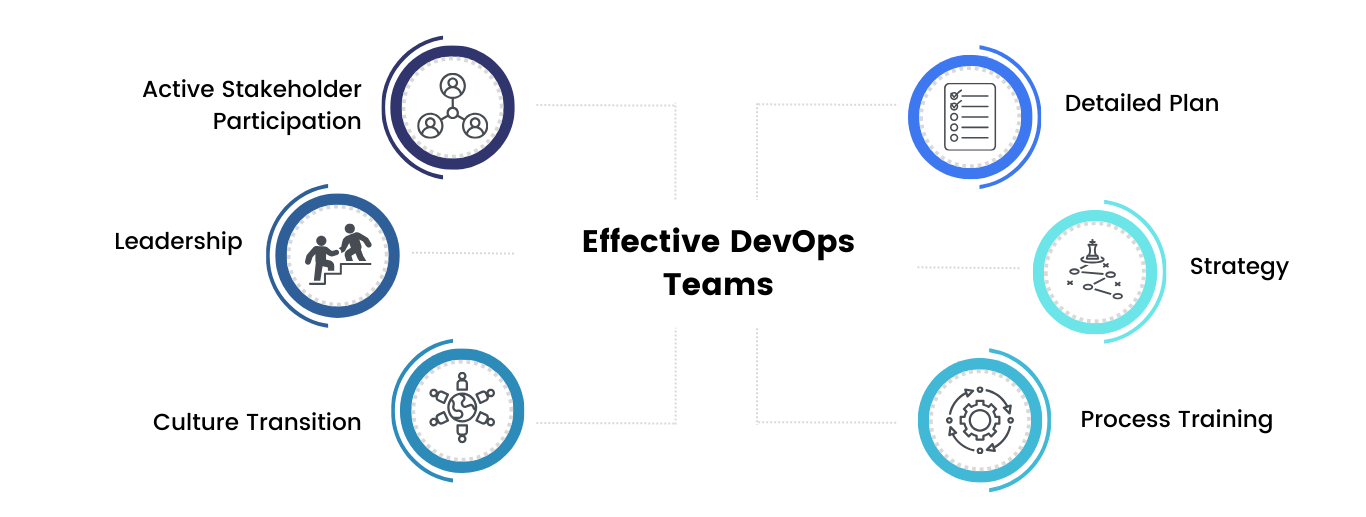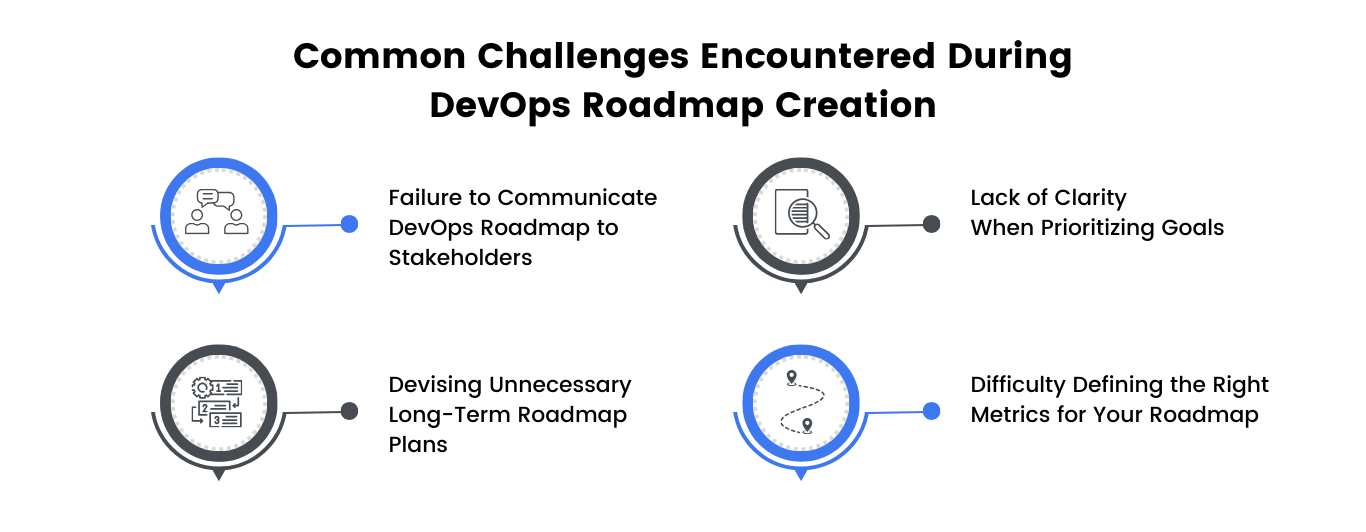DevOps, a portmanteau of "development" and "operations," signifies a cultural shift and a set of practices aimed at breaking down the silos between these two vital domains. Its significance cannot be overstated, as it ensures the efficiency of organizational models and orchestrates a symphony of collaboration, automation, and continuous improvement, resulting in accelerated software delivery and enhanced quality.
At the heart of this transformative journey lies the DevOps team — a group of dedicated individuals entrusted with the task of bridging the gap between development and operations. They are the architects of synergy, the builders of pipelines, and the custodians of innovation. Recall any team sport. Have you seen an unsynchronized soccer team in the Champions League? Well, apart from Manchester United, of course. Okay, forgive us Mancunian fans, it's just a joke. The main point is that crafting an effective DevOps team structure is akin to assembling a finely tuned soccer team, with each member playing a distinct role in taking apart the rivals.
Let’s embark on a voyage through the intricacies of team-based organizational structure. We'll explore the various organizational models, strategies, and considerations that can help you construct a DevOps team capable of propelling your organization into the realm of efficient and collaborative development operations. And we hope we’ll make it as a robust soccer team.
Understanding DevOps Team Structure
DevOps teams are characterized by their shared responsibilities and cross-functional collaboration. Everyone on the team is responsible for the overall quality of the software, and everyone works together to deliver it to users quickly and reliably.
Traditional development and operations teams are typically siloed, with each team having its own set of responsibilities and tools. This can lead to communication and collaboration challenges, and it can also slow down the software development process.
DevOps teams, on the other hand, are integrated and cross-functional. Everyone on the team works together to achieve the common goal of delivering high-quality software to users quickly and reliably.
DevOps Roles and Responsibilities
Key Principles For Building DevOps Teams
Roles and responsibilities are akin to the positions in the soccer team — each distinct yet harmonizing to create stunning performance. Below are the key roles within a DevOps team (extended edition):
Developers: These individuals are the master composers, crafting code and new features. They play a crucial role in the continuous integration (CI) process, ensuring that code changes are seamlessly integrated into the pipeline.
Operations Engineers: Often referred to as "Ops" or "SysAdmins," they are the conductors of infrastructure. Ops engineers manage servers, networks, and deployment environments, ensuring the availability and reliability of systems.
QA Specialists: Quality assurance experts act as the vigilant guardians of software quality. They design and execute testing strategies, aiming to catch bugs and issues before they reach production.
Security Experts: In an era of cybersecurity threats, security specialists are the vigilant gatekeepers. They are responsible for ensuring the safety and integrity of the software, conducting vulnerability assessments, and implementing security measures.
Automation Engineers: These engineers are the automation virtuosos. They create and maintain the automation scripts and tools that drive the DevOps pipeline, enabling efficiency and repeatability.
Release Managers: Release managers oversee the software release process, orchestrating deployments and managing version control. They ensure that changes are delivered smoothly into production.
DevOps Evangelists: These individuals play a critical role in fostering a DevOps culture. They promote collaboration, continuous improvement, and the adoption of DevOps best practices.
Shared Responsibilities: In DevOps, the symphony is not limited to individual roles; it extends to shared responsibilities. Collaboration is the melody that binds the team together. Cross-functional collaboration ensures that the DevOps team collectively owns tasks like automated testing, deployment, monitoring, and incident response. This shared ownership fosters a sense of collective responsibility for the entire software development and delivery lifecycle.
Traditional vs. DevOps Team Structures
Let's compare the traditional development and operations teams with the integrated DevOps approach. The table below clarifies the difference and even underlines the advantages of a DevOps team structure.
| Aspect | Traditional Teams | DevOps Team Structure |
| Team Separation | Developers and Ops are siloed | Cross-functional collaboration |
| Delivery Speed | Slower due to handoffs | Faster due to automation |
| Quality Assurance | QA often comes late in the process | QA is integrated from the start |
| Communication | Communication barriers | Open and continuous communication |
| Responsibility | Clear boundaries | Shared responsibility for the entire lifecycle |
| Flexibility | Less adaptable to changes | Highly adaptable to changes |
In a DevOps team structure, the convergence of roles and the emphasis on collaboration lead to faster delivery, improved software quality, and enhanced communication. The boundaries between development and operations blur, creating a dynamic environment where teams work together to orchestrate the symphony of software delivery.
Building an Effective DevOps Team
Without an effective DevOps team chances are you won’t achieve your business goals. Identify the essential skills required for each role, create cross-functional teams, and establish clear communication channels — and you’ll have the basics for real success.
Identifying Skill Sets
Crafting an effective team starts with identifying the essential skill sets required for each role within the team. Below is a breakdown of these critical skills.
Coding Skills: Obviously, proficiency in programming languages and the ability to write clean, maintainable code are fundamental skills for this role. They should also have expertise in version control systems like Git.
Automation Skills: Automation engineers are the automation virtuosos. They must excel in scripting and using automation tools to streamline processes. Proficiency in tools like Ansible, Puppet, or Chef is valuable.
Infrastructure Management: Operations engineers need to have a knack for server provisioning, configuration management, and cloud services (e.g., AWS, Azure, or Google Cloud). Knowledge of containerization technologies like Docker and orchestration with Kubernetes is gaining ground (always was, to be honest).
Continuous Integration/Continuous Delivery (CI/CD): CI/CD specialists are the conductors of software delivery. They must understand CI/CD pipelines, automation of testing and deployment, and tools like Jenkins, Travis CI, or CircleCI.
Quality Assurance (QA): QA specialists should have expertise in test automation, including frameworks like Selenium, as well as manual testing. Knowledge of performance testing, security testing, and test-driven development (TDD) is beneficial.
Security Expertise: Security experts are the sentinels of safety. They must be well-versed in security best practices, vulnerability assessments, and security tooling. Familiarity with tools like OWASP ZAP and Nessus is valuable.
Release Management: Release managers oversee the orchestration of software releases. They need skills in version control, deployment strategies, and change management.
Soft Skills: Effective communication, collaboration, problem-solving, and adaptability are vital soft skills for all team members. The ability to work under pressure and a commitment to a culture of continuous improvement are also essential.
Creating Cross-Functional Teams
The power of a DevOps team lies in its diversity. Assemble cross-functional teams with diverse expertise, and you will reap numerous benefits. At least the following.
Faster Issue Resolution: When an issue arises, cross-functional teams can quickly diagnose and resolve it. Developers, operations engineers, and QA specialists collaborate to address problems efficiently.
End-to-End Ownership: Cross-functional teams take ownership of the entire software development lifecycle. This holistic approach ensures that every aspect of software delivery, from code creation to deployment, is considered.
Efficient Collaboration: Collaboration between team members with different backgrounds fosters innovation. Diverse perspectives lead to creative solutions and improved processes.
Example: In a cross-functional DevOps team, a developer working on a new feature encounters a performance issue. They collaborate with the operations engineer to analyze server metrics, the QA specialist to identify potential code bottlenecks, and the automation engineer to enhance the deployment process. This collaborative effort results in the swift resolution of the performance issue.
Communication Channels
Effective communication is the heartbeat of any team. It ensures that participants are aligned, informed, and responsive. To establish clear communication channels you need the following.
Daily Stand-up Meetings: Conduct daily stand-up meetings where team members share updates, challenges, and goals. These brief, focused meetings keep everyone on the same page.
Collaborative Platforms: Utilize collaboration tools like Slack, Microsoft Teams, or Mattermost to facilitate real-time communication. These platforms allow team members to exchange messages, share documents, and coordinate tasks seamlessly.
Documentation: Maintain comprehensive documentation of processes, procedures, and configurations. Documentation serves as a reference point and ensures consistency in operations. So if you didn’t plan to hire a Technical writer, change your mind.
Post-Incident Reviews: After incidents or outages, conduct post-incident reviews (PIRs) to analyze what went wrong, what worked well, and how to prevent similar issues in the future. PIRs promote continuous improvement.
Tailoring the DevOps Team Structure to Your Organization
This move is essential for success. By considering your organizational needs and designing a scalable and flexible team structure, you can build a team that is productive, efficient, and collaborative.
Assessing Organizational Needs
When it comes to building a DevOps team structure, one size does not fit all. The success of your DevOps initiative hinges on aligning the structure with your organization's specific needs, goals, and industry. Everybody loves how-to guides. Well, here's it.
Look For Balance With Organizational Goals: Start by understanding your organization's strategic objectives. If you’re a newbie to a company, then ask for an existing business strategy. Consider how DevOps can support those goals. For example, if the primary goal is to accelerate time-to-market for new features, your DevOps team structure should prioritize speed and efficiency.
Size and Complexity: The size of your organization and the complexity of your projects play a significant role in determining your DevOps team structure. Smaller organizations may have smaller, more tightly-knit teams, while larger enterprises might require more specialized roles and larger teams.
Industry Considerations: Different industries have unique regulatory requirements and operational demands. For instance, a financial institution may have stringent compliance needs, while a startup in the gaming industry may prioritize rapid innovation. Tailor your DevOps structure to meet industry-specific challenges.
Assessing Existing Processes: Conduct a comprehensive assessment of your existing development and operations processes. Identify bottlenecks, inefficiencies, and areas where automation can make a significant impact. This assessment forms the basis for restructuring.
Continuous Improvement: DevOps is about continuous improvement. Ensure that your DevOps team structure allows for iterative enhancements to processes and workflows. Flexibility to adapt to changing needs is key.
Scalability and Flexibility
Scalability and flexibility are paramount when designing a team's organizational structure. So it’s high time for the next how-to guide — here we go.
Scalability Challenges: As your organization grows, so do the demands on your DevOps teams. Challenges may include managing more complex infrastructure, handling a larger volume of code, and coordinating the efforts of a growing team.
Team Modularization: Consider modularizing your DevOps teams. Smaller, cross-functional teams can be easier to scale as they can operate autonomously. Each team should have a specific focus, whether it's a particular product, service, or part of the infrastructure.
Specialization vs. Generalization: While many experts stand for versatile teams, recall the little-known Greek phrase: nothing over the top. Strike a balance between specialization and generalization. Specialization allows team members to become experts in their domains, while generalization ensures that team members can flexibly handle different tasks.
Tools and Automation: Invest in tools and automation that support scalability. Automation can help streamline processes, reducing the need for manual intervention as teams grow. Tools like container orchestration platforms (e.g., Kubernetes) can simplify scaling infrastructure.
Agile Methodologies: Adopt agile methodologies like Scrum or Kanban. These methodologies promote flexibility by allowing teams to adapt to changing project requirements and prioritize tasks based on their value.
Cross-Training: Encourage cross-training among team members. While specialization is valuable, team members should have a basic understanding of each other's roles. This enables smoother handoffs and better collaboration.
Continuous Evaluation: Regularly evaluate the effectiveness of your DevOps team structure. Solicit feedback from team members, monitor key performance indicators (KPIs), and make adjustments as needed to ensure ongoing scalability and flexibility.
Best Practices for Maintaining an Effective DevOps Team Structure
Let's recall the metaphor from the beginning of this article. A good DevOps team is like a soccer team. A player at each position is a professional, but he must also be able to replace a player at another position. This makes the difference between a mediocre player and a multi-million-dollar footballer. Versatility, cohesiveness, and intricate knowledge of the subject matter are what distinguish top-notch DevOps teams. So how do you achieve this?
Continuous Learning and Skill Development
To maintain an effective DevOps team structure, organizations must foster a culture of perpetual improvement. Not to be a know-it-all, but here's how.
Embrace Lifelong Learning: The technology landscape evolves at a rapid pace. New tools, frameworks, and methodologies emerge regularly. DevOps team members should embrace the ethos of lifelong learning. Encourage them to stay curious and explore new technologies that can enhance productivity and efficiency.
Stay Current with Industry Trends: DevOps professionals should remain current with industry trends. Follow influential blogs, podcasts, and forums dedicated to DevOps and related fields. Engage in discussions, attend conferences, and participate in webinars to gain insights into the latest developments.
Utilize Online Courses and Certifications: Online learning platforms offer a wealth of courses and certifications tailored to DevOps practitioners. Platforms like Coursera, edX, and Udacity provide access to courses on automation, cloud computing, and DevOps practices. Encourage team members to pursue relevant certifications to validate their expertise.
Promote Knowledge Sharing: Create a culture of knowledge sharing within your DevOps team. Encourage team members to share insights, best practices, and lessons learned from their experiences. Regular brown bag sessions, lunch-and-learns, or internal workshops can facilitate knowledge exchange.
Cross-Training: Cross-training team members in different aspects of DevOps fosters versatility. Developers can learn about infrastructure management, while operations engineers can gain insights into coding practices. Cross-training ensures that team members have a broader understanding of the entire software development lifecycle.
Recommended Resources: Provide team members with a curated list of resources to aid their continuous learning journey. Suggest books, online courses, industry conferences, and online communities where they can connect with peers and expand their knowledge. This can be an internal data base in Notion or Confluence — any tool you prefer.
Regular Performance Evaluation
Continuous improvement requires regular assessment and feedback. Evaluating team performance is essential to identify areas for enhancement and align efforts with organizational goals. Of course, you can't force people to develop and most importantly, to have aspirations for it. Money will only work for a while, in the long run, it is not the answer. However, this is already a question of motivation and HR practices, not of this article. Let's focus on more narrowly focused advice.

Establish Clear KPIs: Define key performance indicators (KPIs) that align with your organization's DevOps goals. These KPIs can include metrics related to deployment frequency, lead time, mean time to recovery (MTTR), and code quality. Clear KPIs provide a tangible measure of success.
Regular Check-Ins: Conduct regular one-on-one check-ins with team members to discuss their progress, challenges, and career goals. These check-ins provide an opportunity to address concerns, offer guidance, and provide constructive feedback.
Peer Reviews: Implement peer reviews as part of your DevOps practices. Encourage team members to review each other's work, such as code, automation scripts, or documentation. Peer reviews foster collaboration and help maintain high standards of quality.
360-Degree Feedback: Consider implementing 360-degree feedback, where team members receive input from colleagues, managers, and subordinates. This comprehensive feedback approach provides a holistic view of an individual's performance and areas for improvement.
Performance Reviews: Conduct formal performance reviews at regular intervals, such as quarterly or annually. During these reviews, set achievable goals and objectives for team members. Align these goals with the organization's strategic priorities.
Recognition and Rewards: Recognize and reward outstanding performance. Acknowledging team members' contributions and achievements fosters motivation and a sense of accomplishment.
Continuous Improvement Plans: Work with team members to create individualized continuous improvement plans. These plans should outline areas for development and the steps needed to enhance skills and performance.
To sum it up
Significance of aligning the team structure with organizational goals, industry-specific demands, and scalability requirements can’t be overrated. A well-structured DevOps team empowers organizations to adapt to the dynamic technology landscape, accelerate delivery, and uphold quality standards. It fosters cross-functional collaboration, innovation, and a culture of continuous improvement. Bad team conditions and poor structure can cost your company an arm and a leg.
As you embark on your DevOps journey, remember that there's no one-size-fits-all approach. Carefully assess your organization's unique needs, size, and industry context to design a DevOps team structure that suits you best. Embrace the DevOps principles of collaboration, automation, and continuous improvement to drive success in today's ever-evolving software landscape.






